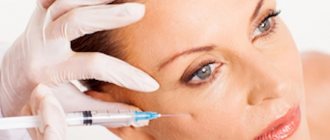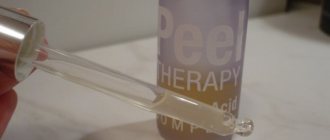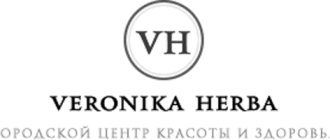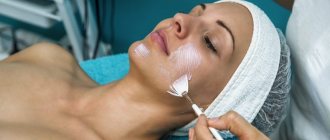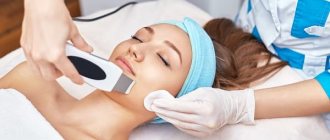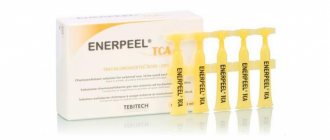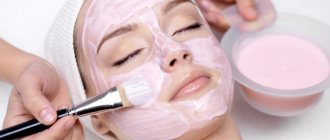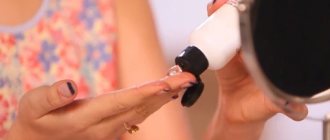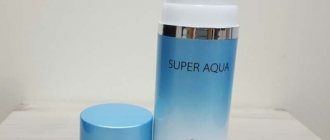- 15673
- 09-10-2020
- Author: Mysekret Team
- 0
As a person reaches a certain age (“critical point” - from 30 years and older), the amount of fibrillar proteins responsible for skin turgor, known as collagen and elastin, naturally decreases. This is expressed in a decrease in skin elasticity, loss of freshness and a healthy natural tone. Facial features also change: the oval becomes wider, the cheekbones and nose stand out more sharply. Fortunately, modern cosmetology has innovative technologies that can slow down the irreversible aging process.
The essence of peeling and biorevitalization
Before identifying the essence of both procedures, it is necessary to understand what goals each of them pursues. The end result, as a rule, is the desire to achieve improvement and noticeable rejuvenation of the facial skin. Modern cosmetology has several techniques used to solve such problems.
One of these methods includes biorevitalization . The complex term hides the well-known injections of hyaluronic acid (hyaluronate). The essence of the technique is to saturate the deep layers of the dermis and epidermis with non-sulfonated glycosaminoglycan, which is part of connective, epithelial and nervous tissues. Transportation of hyaluronate components together with vitamin complexes is carried out through injection or laser implementation of a special gel.
See also...
✅ Facial biorevitalization: description of the procedure, advantages and disadvantages
✅ Facial soda: mask, peeling, scrub
✅ Facial peeling roller: rating of the best!
✅ How often can you do facial biorevitalization?
The beneficial properties of hyaluronic acid include the following:
- Stimulation of regeneration processes in the dermis and epidermis;
- Activation of the natural production of elastin and collagen;
- Reduced activity of the sebaceous glands;
- Smoothing out small wrinkles;
- Normalizing metabolic processes in skin tissues.
To make the effect of the biorevitalization procedure last longer, a course of several injections of the drug is usually prescribed. The duration of the course is determined by a cosmetologist based on the condition of the patient’s skin, her age and body characteristics.
Step by step biorevitalization looks like this:
- The cosmetologist thoroughly cleanses the client’s face using one of the available methods;
- An anesthetic cream is applied to the facial skin for 20 - 30 minutes. This will help reduce pain during injection of the drug into the skin tissue;
- The drug is injected under the skin with a thin needle or using low-intensity laser radiation. The first technique is considered more effective, but it is also more painful.
Often, patients after injection biorevitalization complain of the appearance of hematomas and small swellings on the face (papules). But this is a completely common phenomenon that will go away on its own over the next 1 to 2 days.
Unlike biorevitalization, during deep cleansing of the facial skin, which is peeling , the transport of substances into the tissues of the epidermis and dermis does not occur. Instead, the cosmetologist removes dead epithelial cells chemically or mechanically. In other words, peeling is a forced “launch” of natural metabolic processes in the skin by exposing young and healthy cells. Thanks to this, cellular respiration is stimulated, and beneficial substances enter the skin tissue faster and more actively.
For deep cleansing of the skin, special high-concentration acid preparations are used, the use of which should only be carried out by a specialist. It is not recommended to perform the procedure at home, as this can result in damage to the epithelium and the appearance of burns.
Another popular option is the retinoic or "yellow" peel . It involves exposing the skin to retinoids - artificial analogues of vitamin A. This facial cleansing technology is more gentle: with it, concentrated retinoic acid (tretinoin 5% or 10%) is applied to the skin for a quarter of an hour, as a result of which an occlusive layer is formed on it and, in During this process, the uniform production of tretinoin is stimulated. Typically, a course of “yellow” peeling includes at least four procedures, repeated at intervals of 2 to 4 weeks.
Features of the procedures
It should be noted that peeling and biorevitalization are two completely different techniques in terms of their effects. But both of them have a rejuvenating effect on the skin. After them:
- the functioning of the sebaceous glands is normalized, oily sheen and flaking go away;
- Pores are cleaned, which means the dermis is better enriched with oxygen;
- the production of own collagen is carried out, which leads to the minimization of wrinkles;
- the skin becomes smooth and acquires an even color;
- a lifting effect is provided.
Thus, not only does the skin cleanse, but it also prevents the effects of negative environmental factors and the aging of the body.
By the age of 30, almost every woman begins to develop wrinkles. This process is associated with a slower metabolism and reduced production of collagen and elastane. Turgor is lost, the skin becomes uneven and acquires a grayish tint, unevenness is noticeable, and the oval of the face becomes blurred. But thanks to the miraculous procedures of peeling and biorevitalization, the production of collagen fibers is activated. The procedure is indicated after 28 years.
The essence of peeling
The essence of peeling is that the skin is freed from various types of contaminants - dust, remnants of decorative cosmetics, keratinized scales of the epidermis and subcutaneous fat, called sebum in medical circles. Injection of drugs into the deep layers of the epidermis is not required. By eliminating everything that prevented the dermis from breathing normally, metabolic processes are launched and the skin becomes young.
As you know, the epidermis consists of several layers. On average, on day 28, the top layer peels off. But due to age-related changes, this process slows down. The remaining particles prevent the supply of nutrients, water and oxygen to the skin, and it loses its former beauty. To avoid this, you should cleanse your face from time to time.
Chemical peeling is stressful for your skin. But thanks to the destructive effect of acid on keratinized scales, new (young) cells after the resulting shake-up become more resistant to destructive environmental factors.
With the help of chemical peels, the upper or middle layer of the epidermis is burned out. This shake-up for the body triggers the production of collagen and elastane fibers, and also promotes accelerated regeneration of the skin.
Advice. It is advisable to carry out chemical peels in an office setting, because the specialist will always feel the moment when it is necessary to neutralize the acid, so as not to provoke a severe burn and other side effects.
There are the following peeling options:
- using acids - lactic, glycolic, grape, salicylic, trichloroacetic and many others;
- using special devices - laser, ultrasound, etc.;
- carrying out scrubbing;
- use of fruit-based acid cleansing masks.
Chemical peels with highly concentrated acid are done only in the salon. In terms of savings, it is also advantageous to carry out hardware procedures in a cosmetologist’s office. But you can easily try weakly concentrated acid peels, scrubbing and applying masks at home.
The essence of biorevitalization
Biorevitalization is a popular innovative cosmetic procedure that involves introducing hyaluronic acid into the deep layers of the epidermis in an invasive way, that is, using a syringe. A special gel of animal origin penetrates the skin, fills voids and is not rejected by the epidermis. It promotes:
- improved hydration (you will notice how the dermis has become smoother without peeling);
- production of its own hormone by the epidermis;
- lifting effect - the skin becomes tightened and elastic;
- normalization of metabolic processes and saturation of the skin with vitamins and minerals;
- beautiful smooth peach color.
There are also creams with hyaluronic acid, but their ability to penetrate deeply into the layers of the epidermis is much lower than when using injections. In addition, if you want to achieve a truly amazing effect, cheap cosmetics are unlikely to contribute to this - for a good 30 ml cream you will have to pay 4-5 thousand rubles. An ampoule of gel with hyaluronic acid will cost 7–11 thousand rubles, depending on the brand of the manufacturer.
To get a positive and lasting result, you need to take a course involving several sessions of introducing hyaluronic acid. The number of visits to a cosmetologist’s office is determined by a specialist in each specific case, taking into account the condition of the skin. It is enough to take 2 courses to stay young.
Is it possible to combine?
Biorevitalization has its own characteristics, as does the procedure for deep skin cleansing, and the indications for them are different. Thus, facial peeling is carried out even for adolescents under the age of 18, since it is during puberty that they encounter dermatological problems such as rosacea, acne, acne and increased oily skin. But injections of hyaluronic acid are not indicated for persons under 30 - 35 years old , unless there are special indications for their use.
Most often, when asked whether it is worth combining biorevitalization and peeling, cosmetologists give a negative answer . The impact on the skin during both procedures is quite traumatic and requires some time for natural regeneration. Therefore, if in any salon you are offered to combine them in one visit, we advise you to refuse and look for another place for cosmetic treatment.
Laser resurfacing and fillers
Fillers based on hyaluronic acid can complement each other well, provided that laser resurfacing is performed initially, and dermal fillers are installed after about 2-3 weeks.
The fact is that a laser beam can have a destructive effect on fillers and reduce their effect to zero or lead to deformation.
Ideal combination scheme:
- first perform fractional resurfacing, which removes the top layer of skin and eliminates existing visual imperfections
- then carry out contour plastic surgery, which will fill deep wrinkles, replenish missing volumes and moisturize the skin, accelerating the recovery process.
Sequence of procedures
The main question that clients who want to undergo facial skin treatment and rejuvenation ask at an appointment with a cosmetologist is the choice of the sequence of actions.
What is the best course of action: undergo peeling and then agree to hyaluronic acid injections or change the order of procedures. There is no definite answer to this question, since the specialist will make a decision on an individual basis, based on the characteristics of your body and skin condition, as well as other factors (age, the presence of certain diseases, taking certain medications, etc.).
Both procedures differ radically in technology, type of effect on the skin and materials used during the process. This is also necessarily taken into account when choosing the sequence and tactics of action.
Why is this stage critical? It all depends on which skin cleansing technology is chosen: retinoic (“yellow”) or chemical peeling. The second option is more traumatic , and after it is carried out, the facial skin tissues remain swollen for a long time. If you inject hyaluronic acid within the permitted period after chemical peeling, the regeneration process will be accelerated, due to which the swelling will go away a little faster.
The effect is explained by the peculiarities of the action of hyaluronic acid, which adsorbs excess liquid remaining in the epidermal cells after chemical cleansing. However, biorevitalization cannot be carried out immediately: a certain time interval must be maintained.
Retinoic peeling has a gentle effect on the skin, so biorevitalization after it is carried out in a shorter time. Already on the third day, the balance of vitamin A in the treated skin is restored enough to create a reliable effect against aggressive external factors.
Peeling before biorevitalization
If you are advised to cleanse your facial skin before administering hyaluronate injections, please note that one of the effects achieved will be a reduction in the period of regeneration of the epidermis after the use of aggressive acids.
The selected procedure diagram will look like this:
- To begin with, the cosmetologist will perform approximately two deep cleanses with glycol at intervals of 7 to 10 days. Thanks to this procedure, the facial skin will be exfoliated from dead cells, and active collagen synthesis will begin in its deep layers;
- Then intermediate injections of hyaluronate are carried out after 4 - 5 days;
- After another 5–6 days, the patient undergoes two peeling procedures again with an interval of a week;
- Having completed all these steps, it again undergoes final biorevitalization 5 days after the last peeling.
With this scheme, a complex effect is achieved, namely: the skin recovery period is shortened, the patient practically does not abandon the usual rhythm of life, and the result of the procedure is noticeable to the naked eye after 15 days.
Biorevitalization before peeling
The chosen method of facial rejuvenation, in which peeling is carried out step by step after biorevitalization, also has its own characteristics. They include a special sequence, number and order of manipulations:
- Hyaluronic acid injections are carried out in three doses, with an interval of 15 days between each procedure;
- After this stage, the patient undergoes retinoic peeling. Recovery after cleansing and how effectively the process of facial skin restoration proceeds largely depends on the conscientious implementation of medical recommendations (we’ll talk about them below), which are mandatory during the rehabilitation period.
It is believed that biorevitalization carried out before peeling will facilitate the skin regeneration process and reduce the risk of side effects and complications.
Intervals between procedures
The intervals between procedures are determined by a specialist:
- 7–14 days should pass between aggressive acid peeling and biorevitalization for the epidermis to recover;
- light retinoic peeling is quite compatible with biorevitalization - it can be done on the 3rd day after invasive intervention;
- atraumatic peelings (scrubs, homemade masks based on fruits) can be done the day before the introduction of hyaluronic acid, after - it is prohibited;
- peeling after biorevitalization is possible after 14–20 days;
- The pause maintained also depends on the concentration of acids for chemical peeling or the consistency of the drug injected under the skin (ether or liquid).
Chemical peeling or biorevitalization is done only on healthy skin. The dermis should not be inflamed or strewn with hematomas. If you neglect this rule, you can significantly harm your skin.
Intervals and restrictions
Many patients try to find out on their own, but any responsible cosmetologist, even before the procedure, is obliged to tell you how many days after peeling you can do biorevitalization.
Of course, this time interval should not be very long, otherwise the effect after deep cleansing of the skin will be minimized. The ideal option is to wait about 10–15 days . If you do biorevitalization earlier, it will give an undesirable result, since the skin tissue at this moment is still quite vulnerable. If an atraumatic skin cleansing technology (for example, retinoic peeling) was chosen, the waiting period can be reduced to a week or even five days.
When undergoing chemical peeling, the interval between procedures should be from a week to 15 days. It is better to wait the maximum recommended time, since regeneration of the epidermis after dry cleaning takes quite a long time. If you undergo hyaluronate injections at an earlier date, erythema may develop.
There are certain restrictions imposed on a patient who has undergone a combination of both procedures. This list includes special recommendations, ignoring which may reduce the effect of injections and deep cleansing of the skin:
- Skin exposed to traumatic effects is prone to hyperpigmentation, so before going outside, you should apply protective products with a high SPF factor to your face. This measure must be observed for a month after the procedures, but for skin health it is better to protect it from the negative effects of ultraviolet rays on an ongoing basis. You must refrain from visiting the solarium for at least 15 days;
- While the skin is recovering after visiting a cosmetologist, do not use harsh peels and scrubs, face masks and creams. In order not to provoke the development of a spontaneous allergic reaction, do not try new beauty products and cosmetics for a month;
- Keep antihistamines in your home medicine cabinet at all times. This is a necessary measure for everyone, not just those who are prone to allergies. If, during the recovery period, rashes, erythema and swelling appear on the facial skin due to an allergic reaction, this may negatively affect its condition and negate the effect of peeling and biorevitalization;
- For a week after the procedure, do not expose yourself to physical activity (especially weights). Increased physical activity contributes to a rush of blood to the skin of the face, and this is undesirable;
- For 2–4 weeks, any additional cosmetic and/or plastic correction interventions on the facial skin are prohibited;
- In the first weeks after the procedures, avoid visiting the bathhouse and sauna;
- During the recovery period, stop taking B vitamins.
High tech
Peels are an important part of skin care. The procedure involves removing dead skin cells from the epidermis. With age, regeneration processes slow down, and the skin needs to be helped to get rid of such cells. This can be done in different ways. Mechanical peelings involve grinding the upper layer of the epidermis (for example, using scrubs). Chemical burns are a controlled burn with acids, leading to exfoliation of the stratum corneum. For carbon fiber, laser radiation is used in combination with a special gel.
This combined effect not only exfoliates the top layer of the epidermis, but also cleanses the pores. This type of treatment is considered the most gentle, and, unlike most chemical peels, carbon peeling can be done at any time of the year, including summer.
The procedure is based on the interaction of carbon nanogel with neodymium laser radiation. First, a gel containing tiny particles of carbon dioxide is applied to the face. Activated carbon is famous for its ability to attract and bind toxins. Carbon gel works on approximately the same principle. Nanoparticles penetrate deeply into the epidermis, intensively absorbing skin secretions and impurities.
After this, a laser with a wavelength of 1064 nm comes into play. Under the influence of short pulses of radiation, the deep layers of the skin heat up. This process is called laser photothermolysis.
At the same time, the synthesis of collagen and elastin is activated, regenerative processes are accelerated, cellular metabolism is improved and pathogenic microflora is destroyed.
The heating is very short-lived, so burns are impossible, and there are no unpleasant sensations during carbon peeling. There is no need to use anesthesia.
Thanks to the targeted action of 1064 nm laser radiation, the carbon particles heat up more than the surrounding tissue.
Micro-explosions occur, leading to exfoliation of dead cells and cleansing of pores. Contaminants are literally pushed to the surface. Although the description of the process may seem scary, in fact the procedure is completely painless: the carbon particles are so small that the skin is not injured when they heat up and explode. Only dead cells are removed, making it difficult for the skin to breathe and worsening the complexion (a study on how beneficial carbon peeling is for acne).
Since carbon peeling requires special, expensive equipment and medical knowledge, it is best to do it in a clinic with a cosmetologist.
Although a gel with carbon nanoparticles is commercially available, there is no point in buying it for home use: without exposure to a neodymium laser, it will not be possible to achieve the desired effect. Advertising self-use gels is simply a slick marketing ploy. Without a laser, such products will be no more effective than the well-known (and much cheaper) cleansing masks.
Which sequence is better to choose?
The optimal alternation of facial cleansing and biorevitalization procedures is the one that suits you personally. Each patient has his own characteristics of the body; there are no general recommendations. There is an opinion that the correct sequence of procedures should be determined after at least two consultations with an experienced cosmetologist. The specialist will not only select techniques for your specific case, but will also set the necessary time frames between each stage.
That is why you should not expect a definite answer to the question of what is better – peeling or biorevitalization. Both procedures have different effects on the skin of the face, so it is incorrect to look for their advantages and disadvantages in comparison with one another.
When preparing the material, consultation was carried out by:
Olga Kirilova (cosmetologist). A specialist with higher medical education and extensive work experience. Helped hundreds of patients cope with various skin problems. Conducts non-hardware and hardware procedures. Proficient in laser and phototherapy techniques.
Share with your friends!
more
Read us in the Zen channel
